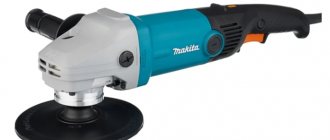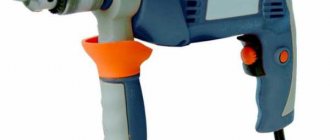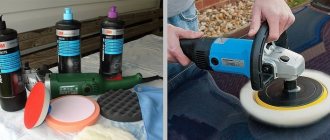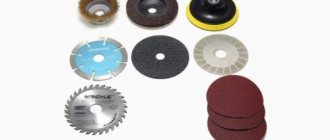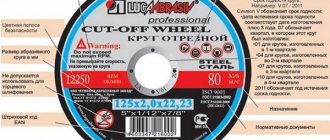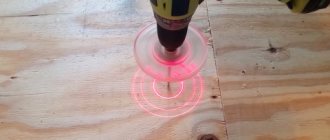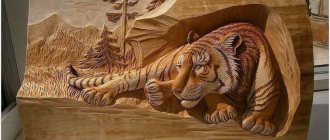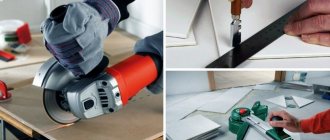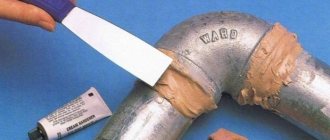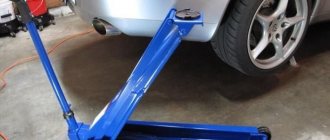Assortment of attachments
The most common products for processing automobile bodies are: sponge-like, abrasive with varying degrees of grain, felt, having a soft surface. They are conventionally classified according to the type of production into two types:
- petal (has high productivity and high price);
- surface grinding (made like a rubber disc with an additional coating for processing).
The material for these items is dense foam rubber or felt, which has different diameters. However, kits are sold that consist of several elements that have different purposes and manufacturing complexity.
Making your own nozzles
If there is no suitable option on sale, then for a disk with a high level of rigidity you can make a soft layer of great thickness and place it between Velcro and a plastic base. Using a utility knife, you need to cut off the Velcro where the soft layer will be glued. For the soft layer, a bath sponge is mainly used. It must be remembered that individual elements can shift, breaking the overall symmetry.
You can also use a felt disc, which is used in a polishing machine and machine. First, you should make a pin with a suitable diametrical size and apply a thread on one side. On this side you need to secure the disk, which is surrounded on both sides by a wide nut and a limit washer. This device is not difficult to manufacture and can be used to process various surfaces.
Application nuances
A drill attachment for car polishing can be purchased at any store that sells car products. However, you should choose these devices carefully.
Body elements of new cars are made using modern technologies. An anti-corrosion compound and paint are applied to the metal, which are wear-resistant. They will last approximately 15 years. However, this coating is better preserved if it is properly cared for. The polishing device restores the original shine and removes defects from the surface. Together with a special product, such a product will cost less than services provided in a workshop.
Areas of application for drill grinding attachments
In many cases, grinding attachments for drills quite successfully replace specialized grinders, which allows the home craftsman to get by with a minimum of power tools when solving his problems. For example, you can use a wire brush to remove rust or old paint, then use a pad of abrasive paper to sand the surface before and after priming, then buff the paint using felt or felt. If you need to install a similar attachment on a screwdriver, use special chucks with a hex shank or adapters. The only limitation of such a tool is the low speed of the screwdriver.
The presence of abrasive rollers of various shapes allows you to bore a hole in the metal to the desired size or give it the required shape. These drill attachments come in many shapes and sizes, so you can always choose one that matches the size and shape of the profile being machined. Sanding plates and drums are often used with a drill secured using special devices in a horizontal or vertical position.
In this version, the drill acts as an improvised mini-sharpener, which can be used both for grinding parts and for sharpening tools.
Body polishing
The polishing process can correct only some defects.
If there is corrosion, chips or damage on the body through which the steel frame is visible, then a major repair will be required. Before starting the polishing process, you should carefully inspect the vehicle to ensure that any imperfections can be eliminated.
Treatment of the body with a special device will give a positive result if:
- slight difference in shades that resulted after partial coloring;
- the presence of roughness, scratches and cloudy stains;
- faded layer of paint;
- the appearance of graininess and streaks of enamel.
You need to know that you can’t overuse polishing, because when you do it, the paint layer becomes smaller by 5 micrometers. From the date of manufacture of the vehicle, no more than 20 polishing procedures can be performed. At this time, you need to use a thickness gauge, especially if the car is used.
Using a polishing wheel
By using a polishing wheel on a drill, you can update the appearance of your car. This procedure is most effective if you need to smooth out small chips or remove tarnishing of the surface.
The work is carried out in 2 stages:
- removing paint from the body surface;
- applying polishing compound.
Protective treatment is also carried out to reduce the negative effects of various types of precipitation and ultraviolet radiation. It is mainly done when preparing a car for sale. A protective layer (it contains wax or silicone) is distributed over the surface of the body to form a film that is invisible to the eye, repels moisture, and makes the body shiny. You can polish a used car with a soft pad if there is no paint damage. It can also be used with careful treatment with a protective agent.
How to polish a car at home
Preparing for body polishing
After washing the car, you need to dry it and cover parts of the car with adhesive tape so that abrasive products do not damage them.
Video: Self-polishing preparation
- Carrying out washing The car is thoroughly washed using detergents; The body is cleaned of bitumen, primer, anti-corrosion treatment, etc.; Seal the areas that do not need polishing using special tape (paper). These are plastic, rubber parts, headlights;
- What the room should be like To perform high-quality polishing of a car body, you need to carry out preliminary preparations and create conditions. For this, a suitable closed room is selected, with limited dust ingress and reliable ventilation. One of the significant conditions for selecting a room is the absence of direct sunlight in the room, as this can cause the polishing components to dry out too quickly.
- Of course, you should provide excellent lighting in the room in order to see and identify various defects in the car body. If you are unable to find a room, then it is advisable to carry out work outdoors in the shade.
Polishing process
Video: How to quickly and easily polish a car
1. Body cleaner 2. Scratch remover (Anti-scratch) 3. Professional polishing paste (abrasive) Farecla G6 4. Fine polish (finishing) Runway
1) So, the car is washed and free of insects and heavy dirt.
- It is necessary or desirable to carry out an operation to degrease the body using a degreaser, for example, W900 APP, or white alcohol. With these products, dirty film is removed from the body, small stains are cleaned, and the car body is prepared for work.
- To carry out protective polishing, the paste is applied to a piece of clean rag and rubbed in a circular motion over the body. However, do not get carried away with applying an excessively thick layer. This will cause the surface to become cloudy, which is difficult to correct. It is better to carry out polishing in small parts, since the paste dries quickly and while you are busy polishing the hood, it may already dry out and become rough in another place. The body must be protected from exposure to direct sunlight.
- After applying the polishing compound, do not rush, you need to wait a while for a white film to form, after which the area is sanded with a soft and dry cloth. In this case, do not use any towels, but use a special microfiber car cloth. There is a very expensive branded option on sale, but if you want a less expensive one, then use Taiwanese-made napkins. The Chinese produce such napkins with synthetic thread, which, with prolonged use, can cause minor scratches.
- Sanding a body by hand is a very labor-intensive process, and therefore a special polishing machine is often used, or a drill is used.
Materials for car body processing
To carry out the car processing procedure, the following materials are needed:
- foam;
- sandpaper;
- grinding compound;
- bike;
- polish.
The product that will be used to treat the body surface must be selected carefully.
A paste containing abrasive particles is needed to remove the top layer of varnish. It must be selected depending on the type of cracks and chips present on the body. A product with a large number of particles is necessary if the defects are very noticeable. Nowadays there is a large assortment of drugs on sale that add brightness to color. The protective coating of a new car may develop cloudy streaks. In such a situation, a restorative paste containing a grinding additive will be sufficient.
A variety of tools allow you to solve any problem. For vertical surfaces it is convenient to use a thick paste. It can be used to process any part of the machine. It is often added to components that increase the brightness of the color.
Protective polishes
After treatment with abrasives, restoration polishing pastes, filling microscratches, level the surface of the car enamel, correctly reflect light rays, which gives the paint a mirror shine. But restoring polishing does not protect the body from new damage. Protective polishes are designed to prevent minor paint damage.
READ What is the difference between a screwdriver and an impact driver
Manufacturers produce protective varnishes based on:
- Artificial and natural waxes;
- Teflon
- Wood resins;
- Silicon;
- Ceramics;
- "Liquid glass".
Before choosing a polishing paste for protective polishing, you should carefully read the instructions for use. Some of them can be applied to the machine by hand, others require the use of a mill.
The principle of operation of protective pastes is the same. They create a thin layer of paint that protects the enamel from ultraviolet radiation (paint burns less) and repels water, dirt and chemicals.
Simple soft pastes include waxy compounds that can be applied to the body with your hands and rubbed in with a special napkin. The car owner can apply preventive protection to the car body within an hour, but the soft paste can only withstand two or three contact washes.
Polishing protective pastes based on silicone and Teflon are stronger. They can withstand 30.40 washes, but you need to polish the car with a sanding machine with replaceable attachments. The polishing technology is similar to abrasive, but requires precise holding time depending on the drying of the protective composition.
For more expensive nanoceramic protective polishes, the hard outer layer is created by polymerized compositions containing tiny crystals of silicon dioxide and titanium oxides. A layer of polymer ceramics fills uneven paint, tightens microcracks, and protects the enamel from peeling. The protective properties of nanocreams increase depending on the applied layers of varnish (use up to ten layers). Professional polishers highly value ceramic varnish, NANO POLISH, CERAMIC PRO LIGHT, Restor FX varnishes. Determining the effectiveness of protective polishing is quite simple. If you pour hood water on the hood of a car, the liquid will accumulate on the surface in large drops.
Compositions under the common name “liquid glass” contain plastic solutions of silicon dioxide and sodium silicate, which, when cured, fill microdamages and uneven enamel. The mirror layer of silicon compounds obtained from quartz sand is heavier than automotive coatings, so it becomes a reliable and durable paint protection. After polishing, the car should not be washed for approximately two weeks until the protective layer has completely hardened.
By doing your own abrasive polishing, polishing your car with strong protective compounds will restore your car to its original appearance without the appearance of a new car. Protective polishing operations that need to be repeated once or twice a year will reduce the need for abrasive restoration.
Source
Why do you need to polish a car body?
Polishing is the process of rubbing a car body with special lubricants that protect the paintwork and remove minor scratches. In order for the car not only to be clean, but also to shimmer in the sun, it is necessary to regularly carry out polishing operations. These operations allow you to solve a number of the following problems:
- Avoid premature destruction of the paint layer
- Protect the body from corrosion
- Make the paintwork shiny, which allows you to effectively highlight your car
- Remove minor scratches and abrasions of the paint layer
To carry out polishing operations, you will need the following set of tools and consumables:
- Power tool - this can be an angle grinder or grinder, drill, screwdriver, eccentric or polishing machine. When using an angle grinder to polish a car body, you need the tool to have a speed control option
- Car polishing nozzles are special devices made of soft materials, through which polishing paste is rubbed into the paint layer of the body. Exactly what types of nozzles for car polishing there are, how they differ, and for what purposes they are intended, is described in detail in the material
- Adapter, mandrel or plate - a device onto which the polishing attachment is attached. Such adapters have appropriate fasteners for installation in the chuck of a drill, screwdriver or on the spindle of an angle grinder and polishing machine. The adapter is used for removable drives, but there are also non-removable devices. They are less popular because they are more expensive. Fixed nozzles are equipped with fastening elements and therefore do not require the use of adapters. It is important to note that the plates are available in diameters of 115, 125 and 150 mm. In addition, they can have a hard and soft base on which a polishing disc is attached. The soft layer on the plate eliminates the beating effect (the vibrations of the power tool are smoothed out), which is especially important when working with sheepskin attachments
- Polishing paste is a consumable material that protects the paintwork of the body, removes scratches, and also achieves shine.
Nozzles for car polishing. Result of application
Hi all. Today's set will be dedicated to car polishing attachments that I purchased on Aliexpress. I somehow set out to tidy up the paintwork of my car. After watching enough on YouTube and reading all sorts of different articles, it became clear to me that there is nothing complicated about it. All you need is the necessary tool, a little time and a lot of patience. Fortunately, the most expensive device, without which the polishing process is simply impossible (and even if it is possible, it becomes much more difficult) - I already had an angle grinder. So the matter remained with polishes and attachments for that same sander. Since I was very passionate about the idea of giving my iron horse an elegant shine, I first of all went to the nearest market, where the accessories I needed were sold. And here the first (by and large, last) obstacle awaited me - they wanted $10-15 for a polishing attachment. And taking into account the fact that you need at least two attachments, and preferably three, I had to pay from $30 to $45 for them, which is not so little. And since I didn’t want to part with such an amount, I had to consider other options - buying the things I needed in China. Fortunately, there are no problems with this; there is an overabundance of attachments of all sizes and colors. You can immediately buy the set you need, or you can, like I did, try to save a little more and buy everything separately.
In order to select the necessary parameters of the ordered product, you can study the inscriptions on the sander. In my case, everything was written out there.
Two main values are important here - the diameter of the circles suitable for use (in my case, 5″ or 125 millimeters), as well as the mounting size (I have M14). Knowing all this, you can order.
1. The main attachment, which is installed on the sander and to which the polishing wheels are attached, was purchased here and at the time of purchase it cost $2.99.
2. A set of 4 polishing wheels of suitable diameter was ordered here for $2.48. There are sets for 6, 7, 8 and more laps, but it seems to me that this is too much.
The parcels did not have full tracks, but the delivery times from China to Belarus were approximately the same. If anyone is interested, the movement of one of the parcels across China can be seen here.
After receiving the orders, I went to the dacha to bring my plans to life. So, in order to add shine to your favorite car, we will need: - ordered attachments; - angle grinder; - polishes (abrasive, “fine” and color-matched polish - optional); - a sheet of sandpaper with a grit of 2000 (not included in the photo).
Now a few words about the ordered attachments. I have no complaints about them. The base (hard rubber nozzle) came without any packaging, the seller even spared the pimples. She sat perfectly on the sander. The nozzle is made of a piece of black rubber, there is no foreign smell, and it looks quite neat in appearance. On its back side you can see the diameter, as well as the maximum number of revolutions at which it can operate.
The front part of the nozzle is covered with a “hedgehog” made of Velcro. It is in this way that the polishing wheel is fixed. They fit perfectly and fit securely. In all the time I spent working on the car, not one of the circles came off. And after the work is completed, it looks like new, only a little whitened 
Unlike the base, the polishing wheels came to me sealed in a plastic bag. I have a set of 4 attachments, which were more than enough for me to completely polish the entire car body. The nozzles have different hardness, which can be easily determined even by touch. In the next photo they are arranged in order of decreasing hardness: orange is the hardest, yellow is the softest (although in this property it is very similar to black).
The diameter of each circle is 125 millimeters.
Height (thickness) 30 millimeters.
The back side of each attachment is covered with a soft material that adheres well to the base.
This is what everything looks like assembled.
Thanks to the shape of the pattern (not even, but with protrusions), polishing wheels perfectly polish so-called holograms - uneven shine visible on paint in good lighting.
Those same holograms, by the way, look like this (the photo is not mine - I took it online):
So let's get started.
By the way, there are no difficulties with polishing a car. First, wash the car thoroughly, remove all dust and sand from the surface of the body (from those areas that we will polish). Then, using a not very active solvent, we remove specks of bitumen, resin and other contaminants that could not be washed off with water.
To be honest, I think that my machine has never undergone such a procedure before. Before I got to work, the paint did not shine at all, was covered with many small scratches and incomprehensible inclusions, and was rough to the touch. Upon closer inspection, it was not blue, but like this:
Before I got to work, the paint did not shine at all, was covered with many small scratches and incomprehensible inclusions, and was rough to the touch. Upon closer inspection, it was not blue, but like this:
We take water, sandpaper and begin to rub the body/particularly damaged areas until the varnish begins to peel off with the dirt embedded in it. Unfortunately, there aren’t very many photos of the process, because either my hands were wet or dirty, or the polish dried out (which should not be allowed)…
The main thing here is not to overdo it and not to rub the varnish down to paint. Although the rubbing process can be felt perfectly, as soon as the sandpaper begins to glide easily over the surface, it’s time to move on to another area. I worked in stages - front fender, door, second door, rear fender, trunk, etc. We wash away everything that has been rubbed off. You should get this unsightly matte surface. And yes, if you don’t specifically set such a goal for yourself, it’s very problematic to remove all the varnish to paint using 2000 sandpaper...
Wipe everything dry. We take an abrasive polish (I bought it by weight, 100 grams cost me $5, enough for the entire body and still have a little left), the hardest (orange) nozzle and start polishing. First one element, then another. And so the whole car. Here in this photo you can clearly see the border on the untouched (left) and already treated (right) side of the hood.
After the whole car has gone through roughing, we change the polishing wheel to a softer one and take a “fine” polish. In my case, the wheel was black and the polish was DoctorWax DW8307. The process is completed using the softest wheel and colored polish (K2 ColorMax).
As a result, here is a photo of the roof - remember what it looked like before (photo with inclusions)?:
I now have the same pleasant, even blue color with a mirror reflection of surrounding objects all over my car. So I was more than satisfied. The purchases turned out to be good. I was completely satisfied with the result, and the costs were minimal. In total, it took me about $15 for attachments and polishes, and about 5 hours of work (I worked on the car in the evening after work for 2-2.5 hours). If I bought the necessary attachments offline, this amount would increase to about $50. And if I gave the car to a specialist for polishing, I would have to pay about $100-120.
So I was more than satisfied. The purchases turned out to be good. I was completely satisfied with the result, and the costs were minimal. In total, it took me about $15 for attachments and polishes, and about 5 hours of work (I worked on the car in the evening after work for 2-2.5 hours). If I bought the necessary attachments offline, this amount would increase to about $50. And if I gave the car to a specialist for polishing, I would have to pay about $100-120.
To summarize everything that is written here. I can say that the attachments are definitely worth their price. In addition, they turned out to be very durable, they will definitely be enough for more than one car. In addition, the process itself turned out to be not so difficult, so anyone can do it. There are nozzles of different diameters on sale (even for a drill), but something tells me that it is unlikely that it will be possible to process the entire body with such a tool. But if you need to polish a small scratch or a small area, then these will do too.
I can say that the attachments are definitely worth their price. In addition, they turned out to be very durable, they will definitely be enough for more than one car. In addition, the process itself turned out to be not so difficult, so anyone can do it. There are nozzles of different diameters on sale (even for a drill), but something tells me that it is unlikely that it will be possible to process the entire body with such a tool. But if you need to polish a small scratch or a small area, then these will do too. Here, as they say, it depends on the taste and color...
Here, as they say, it depends on the taste and color...
Basically, that's all. Thank you for your attention and your time.
Types of polishing work
First, let's understand that car polishing is classified into two main types of work:
- Protective - such operations allow you to ensure reliable protection of the paint layer from minor mechanical stress, abrasions, and even to avoid the varnish losing its characteristics. Pastes used for rubbing car bodies include substances such as Teflon, wax, etc.
- Restoration is the most common type of work in which car owners resort to polishing the body of their car. They resort to restoration work to remove minor scratches and other types of deformation of the body paint, for example, paint fading in the sun. The principle of restoration work is to remove the top oxide layer. For this purpose, special types of polishing pastes are used. After carrying out restoration work on polishing the body, it is imperative to rub the body with protective paste
You need to decide on the type of polishing work in order to choose the right attachments. After all, the quality of work depends not only on the substance used, rubbed into the body, but also on the material from which the nozzle is made.
How to polish a car at home
Naturally, at home you need to understand it in a dry, well-lit garage. You cannot polish your car on the street or in the yard, even in warm summer. Dust brought by the wind and fallen leaves instantly destroys the results of your work. Uneven drying in the sun of many types of pastes and varnishes is also important, which affects the quality of work and the overall appearance of the machine.
READ Stihl 250 Won't Start When Hot
Preparatory operations
Before starting work, it is necessary to clean the garage, removing as much dust as possible. Experienced auto mechanics do not recommend polishing a car at sub-zero temperatures or at high temperatures (more than 35-40 degrees). Before you start polishing, you need to perform a number of preliminary operations:
- Body washing (manual or non-contact);
- Removing stains and stubborn dirt (oil, bitumen);
- Bonding of decorative parts (chrome, nickel, rubber, plastic);
- Inspection of a clean body (choice of abrasives, grain size of polishing compounds depends on the degree of damage).
After washing, stains of bitumen and oil are clearly visible, which are removed manually with mild solvents, degreasers, and white spirit. No need to use screwdrivers or knives. Once the speck is moistened, it can be easily removed with a fingernail or a plastic card.
In order not to damage decorative elements (glass edging, moldings, mirrors), they are glued using adhesive tape. Professional polishers also remove nickel-plated door handles, but this is not recommended for beginners in their first experiments.
Experienced do-it-yourselfers polish the car windows while polishing the body. Technologically, the operations are slightly different (only in the composition of the pastes and protective agents), but as you gain experience, you can polish the glass yourself. It is better to close all windows on the first polishing attempt.
Restorative abrasive polishing of the body
Before you grind the machine yourself, you need to take care of the tools and consumables. There are two methods for abrasively repairing damage to a paint layer. Manual and mechanical (using a grinder). Experts advise beginners who are starting to work independently to first try abrasive polishing, which requires less material costs.
What types of nozzles for polishing a car body are there?
Depending on the type of polishing work, it is necessary to use appropriate attachments. When using protective pastes, delicate nozzles are used, and if it is necessary to remove scratches and abrasions of the paintwork, you will need to use abrasive devices. The polishing procedure can be carried out using drills, screwdrivers and grinders. To do this, it is not at all necessary to buy special polishing machines. Only when using the power tools in question, one detail needs to be taken into account - they must have a speed control function.
Now let's look at the types of polishing attachments for cars. They are made from different materials, but the most popular are foam and sheepskin attachments.
Kinds
The following types of products are used to polish a car:
- felt They are represented by soft felt products. They are cylindrical or flat. This nozzle is used to clean the car body before the main polishing;
Types of car polishing attachments
- from sheepskin. Presented with a cap and used for final polishing;
- from foam rubber. Please note that the smaller the cells on the foam rubber, the more invisible the leveling effect;
- circles. Consist of cords made of fabric or leather. The drill attachment in the form of a circle is used before polishing even and uneven surface areas. Leather tools are suitable for carefully processing products with varnish or acrylic paints. Cord starter bits are used to machine metals.
In addition, polishing attachments, depending on their appearance, are divided into:
- petal;
- surface-ground.
Before starting the procedure, a special product is applied to the treated area (for example, 3M car polishing paste). During the procedure, the polishing attachment on the device distributes the paste over the area, giving it more shine.
Polishing attachments for drill
See also:
Abrasive car polishing
Felt or felt polishing supplies for car
Felt or felt - felt tips are extremely rare. They are intended for cleaning the body surface before polishing, as well as at the final stage of using polish. Felt nozzles are characterized by increased softness, and they are available in cylindrical and flat shapes. They are not suitable for cases where it is necessary to remove minor defects on the car body. They are used with a drill, screwdriver and grinder that has a speed control function. Their disadvantage is that due to the dense base, the car body heats up.
Sheepskin nozzle for car polishing and its types
Sheepskin attachments for drills and screwdrivers are used to apply a protective layer of polishing paste, as well as remove scratches and other defects. For this purpose, sheepskin equipment is available in different types - regular or classic pile, natural sheepskin, and also twisted pile.
Many people mistakenly believe that sheepskin is intended for finishing or for applying a protective layer. However, this is not at all true. They are intended for starting treatment and removing scratches. After their use, small marks remain, so they are not suitable for finishing. That is why, after using sheepskin equipment, it is necessary to use foam rubber attachments. The length of the pile of sheepskin nozzles ranges from 25 to 40 mm, and the larger their size, the better the cooling.
- Classic sheepskin.
The use of classic sheepskin devices makes it possible to achieve a special shine of the paintwork, which is why they are often used at the final stage for almost all car models, from domestic to foreign cars. - Twisted pile.
With twisted pile, sheepskin is intended for rough or aggressive polishing, that is, when it is necessary to remove small scratches and other paint defects - Natural sheepskin for delicate processing.
The equipment is made of natural sheepskin, which is yellow in color, provides the most gentle effect, and is used for finishing. Typically, devices made from natural sheepskin are used to process German-made cars - BMW and Mercedes-Benz. They differ from the first two options in their high cost, which is due to their production from the wool of rare animals
All types of sheepskin polishing equipment are designed to operate at speeds from 400 to 1500 rpm. This speed mode ensures their maximum efficiency and productivity.
Types of car body polishing
- Restorative. It is carried out to eliminate small scratches that have a shallow depth. If damage to the paint layer occurs before the primer itself, then polish will not help. Restorative polishing can remove various abrasions, streaks and stains. The work involves mechanically removing the thinnest layer of coating using abrasive pastes. During the work, about five microns are removed, but there is a clear dependence on the grain size of the paste. This is not much for the original factory coating, since the thickness of the varnish and paint can be from 100 to 150 microns. Most often, this type of work is used before selling a used car to give it a marketable appearance. Let us add that restorative polishing should not be used too often, since it can be sanded to such an extent that places where the primer can be seen through the paint will be visible.
- Protective polishing . Produced to protect the body from adverse environmental influences. This type of polishing work is carried out without the use of abrasive pastes. It is carried out using a non-abrasive polish created on the basis of synthetic substances and various types of waxes. During body work, the paint layer is not removed at all. Protective polishing is ideal for new cars to protect the car body from minor damage.
The period of time during which protection will be effective depends on the composition of the mixture. For example, a protective layer applied with a polymer polish protects the car body for at least six months, and one based on silicone or wax – for several months. But if you apply a polymer polish, it will require more time and appropriate special equipment.
Foam polishing attachments types and purposes
Foam nozzles are used not only for applying protective, but also restorative polish at the finishing stage. Manufacturers produce foam nozzles in a wide variety. The foam base differs in the size of the cells, and the smaller they are, the correspondingly softer the effect. To remove small scratches from the car body, you need to use foam rubber attachments on a drill and a screwdriver with large cells of increased rigidity. Different colors of foam nozzles allow you to accurately apply the appropriate pastes.
Foam nozzles are available in two types - petal (with a grooved base) and flat. They differ not only in appearance, but also in the quality of surface treatment. Flat ones carry out the same type of surface treatment, while petal ones, due to their protrusions, allow for delicate processing due to the small area of their contact. Corrugated ones are used for applying wax, as well as removing holograms - small marks on the paintwork. The advantage of corrugated tools over flat ones is that they do not heat up the surface being treated too much.
Video: How to Polish a Car with a Screwdriver
For manual sanding of paints and varnishes you will need:
- Abrasive sanding leather (P-2000, P-2500);
- Water sprayer;
- Special napkins or cotton fabrics;
- Polishing pastes and polishes.
Body grinding operations
Before use, the sanding cloth is cut into small pieces and their edges are rounded so that sharp corners do not leave deep scratches. Hand sanding begins with a small area of the body, then moves away from it in different directions. Before grinding, the surface is moistened with water from a spray bottle.
The paint, impregnated with sandpaper, is sanded in two perpendicular directions, ensuring a uniform matte paint color. The process is repeated several times, wiping the water with a damp and dry cloth. After R-2000 leather, a second sanding can be done with P-2500 leather. After this, using a fine-grained sponge or plastic card, polishing paste is applied to the polished surface and rubbed with force using circular swabs with special swabs or napkins.
READ How to trim laid laminate flooring near a wall
Polishing after sanding will be much faster if you use a sander. Instead of a machine, you can use an electric drill with a special attachment (only variable speed drills are suitable).
For mechanical polishing you will need to add the following tools to your initial kit:
- Grinding machine (with adjustable speed from 700 to 3000);
- Safety glasses;
- Grinding and polishing of discs;
- Mandrels for fastening discs of various thicknesses;
- Felt or fur sanding wheels;
- A hard brush for cleaning circles.
During the mechanical grinding process, the machine moves in a circular motion. Start at low speeds, being careful to rub in the polishing paste. Over time, the speed increases and the pressure decreases. They start working with pasta with large grains and hard circles. As a result of polishing, they are successively replaced by softer wheels and pastes with a low grain content.
Operating a sander requires proven skills, so before you start sanding your car body, you may want to practice using the removed body part. If the paste grain size, disk rotation speed and pressure are chosen incorrectly, car enamel can wear down to metal and burn out (rainbow spots of discoloration appear, paint swells). Particularly important places. Excess body, curly embossing on the hood, fenders, doors that need to be sanded with special care.
What are the pros and cons of car polishing attachments?
Knowing what types of polishing equipment for car bodies are produced, it will be important to consider their advantages and disadvantages. First, let's look at the advantages and disadvantages of foam discs.
- Foam rubber wheels for cars have disadvantages such as heating the surface being treated and high paste consumption
- The advantages of such devices include a wide variety of choices and affordable prices.
For comparison, let's look at the pros and cons of sheepskin attachments for polishing a car:
- Pros: effective in removing scratches (even the largest ones), they do not consume a lot of paste, which means they have low consumption. In addition, such discs do not heat the surface, which is very important when polishing by beginners.
- Disadvantages - they do not allow for finishing, as they leave small scratches and holograms. In addition, their price is higher than foam rubber, and there is little choice
Based on the advantages and disadvantages of both types of polishing attachments, we can draw a conclusion about which types should be chosen in specific cases.
How to choose a nozzle for polishing tasks on cars?
Good professional car polishing attachments are usually sold for a special machine. You can purchase an adapter for a drill so you can do the work yourself without having to take your car to a service center. Polishing can only be carried out with high quality if the necessary materials are available. Among craftsmen they are often called polishing pads. When choosing such a product for your car, you should pay attention to the following features:
- Manufacturer. High-quality polishing of car body parts is impossible if you choose cheap products from unknown brands. This will bring certain problems.
- Price. Budget solutions will not always be a profitable purchase. For independent work, it is worth buying high-quality expensive tools.
- Purpose. Different parts of the car will require different solutions. Metal needs to be polished with specific parts; only specific solutions should be used for headlights.
- Revolutions. The manufacturer indicates on the packaging the number of revolutions for which the polishing tool is intended. These characteristics should not be changed during use.
- Versatility. If you use an attachment for polishing processes with a drill, it is worth purchasing a universal solution. Often the professional options will not be the best.
Restoring a car body can be quite simple. To do this, you just need to purchase materials of decent quality and read the instructions for performing all the processes. If the work is not performed efficiently, then the results will be difficult to predict. To ensure that the polishing attachment for your drill lasts a long time and does all the work, just buy products from well-known and trusted manufacturers.
How to choose a car polishing attachment
You can perform high-quality polishing of a car body not only in a specialized car service center, but also at home. The quality of the work largely depends on various factors, but one of them is the choice of the appropriate nozzle. When choosing polishing attachments for a drill, screwdriver or grinder, you need to consider the following factors:
- Manufacturer and price - if you set out to produce high-quality polishing of the car body, then you need to approach this issue with the utmost rigor and seriousness. Buying cheap little-known attachments or without a manufacturer’s name at all is dangerous because you will not only not be able to get the desired result, but will also ruin the paintwork. That is why it is better not to save money and choose equipment from well-known manufacturers such as 3M, Mirka and others
- Purpose - it all depends on what goals you are pursuing. For protective polishing, soft nozzles are used, and to remove scratches and other defects, abrasive nozzles with a high degree of hardness are used. To polish car headlights, completely different types of attachments are used, so you should not combine them and make them universal
- Speed of work - this factor also needs to be taken into account, since failure to use the equipment at speed will lead to the fact that you can “burn out” the paintwork of the body. On the nozzles, manufacturers indicate the recommended speeds for their use, which also determines the choice of a suitable power tool for the job.
- Size or diameter. Round nozzles are produced with a diameter of 115 to 150 mm. It is important to take this value into account if you plan to carry out work using an angle grinder or a grinder. If a drill or screwdriver is used for polishing, then it does not matter much what size the adapter and working equipment are. The larger the diameter of the equipment, the higher the processing speed, however, it is not recommended for a beginner to buy a device larger than 125 mm, since the processing procedure becomes more complicated due to high vibrations and the need to control the surface being processed
- Type of nozzle - they are removable and non-removable. They differ only in price. Beginners are recommended to use removable attachments, as they allow polishing with quick replacement of attachments.
There is no clear answer to which nozzles are best to use for polishing a car body. To achieve the result, you will need to buy a set of appropriate equipment. However, purchasing such a set is not a guarantee that the work will be done with high quality. Pay attention to what types of polishing pastes for cars there are, and how to choose them (link). To polish hard-to-reach places, for example, cast car wheels, specially shaped equipment is used - cylindrical, conical and others.
To summarize, it should be noted that before polishing a car body for the first time, you must first practice on other surfaces. The wrong choice of nozzle for roughness, as well as rotation speed, will lead to immediate damage to the paintwork. That is why it is very important to be responsible when choosing power tools, polishes and attachments for polishing a car.
Car Polishing Attachment for Screwdriver
What attachments are used to polish the body with a drill?
The appearance of a car often worries owners no less than its technical condition, which is why some people often polish the body. This not only allows you to give the car a representative look, but also additionally protects the paint layer from early destruction. Well-chosen drill attachments for car polishing will allow you to complete the work very carefully, ultimately obtaining an excellent result.
Content
What attachments are suitable for polishing cars?
Usually, if you set a goal to polish a car using a drill, you use the following types of attachments:
- Felt nozzles, which are soft circles made of cylindrical felt, as it is also called, are flat in shape. Such nozzles are used both for cleaning the surface before polishing, and also for final polishing of the surface.
- sheepskin cap type attachment The introduction of such an attachment gives a truly brilliant result.
- Circle attachments consisting of a fabric cord, otherwise covered with leather. With the help of such attachments there is an option to clean products before polishing, and they are suitable for both flat and embossed surfaces. Leather circles are softer, therefore suitable for delicate processing of varnish or acrylic products, but attachments made of fabric cord are used for metal processing.
- Foam rubber nozzles. When purchasing such attachments, you should take into account that the smaller the cells on the foam wheel, the softer the polishing effect will be.
READ DIY grass trimmer attachment
In addition, drill polishing attachments are divided into two categories based on their shape:
To process a car body with a drill, you will need an adapter - a device on which an attachment or polishing wheel is attached.
Before you start polishing, you need to apply a thin layer of a special product to the surface. During operation, the nozzle will distribute the product over the surface, making it shiny.
Types of car polishing
There are two methods of polishing a car
:
- protective (delicate);
- abrasive (restorative).
The protective method of polishing is a kind of prevention that allows you to maintain the paintwork of the body in its original form. For this treatment, a non-abrasive polish (wax, Teflon) is used, which refreshes the color and smoothes out microcracks.
The abrasive method is relevant for eliminating small defects: plaque, small cracks and chips. For such polishing, abrasive agents are used, the use of which is carried out as follows:
- Existing defects or the oxide layer are removed using sandpaper or abrasive polish.
- The final surface treatment is carried out using non-abrasive products and special attachments for a polishing machine or drill.
Polishing your car yourself using a homemade nozzle
Homemade nozzle
from a dishwashing sponge. You will need a bolt, a nut and two washers, twist and apply.
TOP Cool thing from Aliexpress Screwdriver attachment for polishing COMPETITION
Nozzle
using a screwdriver or how to easily clean a bathtub, stove, or polish headlights.
Set for polishing
headlights and body.
READ Brush for DIY Screwdriver
Experts do not recommend using it for car polishing.
grinders, since most models of grinders do not have a speed controller, while on a drill this indicator can easily be set in the required range. If you still plan to use an angle grinder, you should not process the bumper, headlights and moldings with this tool to avoid damage to them.
Nozzle hardness
Wheels for polishing cars differ from each other not only in the material from which they are made, but also in the degree of hardness. Drill attachments (circles) can be of the following types:
- Solid. They are used to remove scratches and small chips from the car body.
- Soft and medium. Used to give the surface a beautiful glossy shine.
- With a relief surface. They are used if there is a large amount of work to be done to make the car body shine.
Experts recommend using several attachments when working - from harder ones at the initial stage of surface treatment to soft ones, which will be required at the final stage of polishing.
Tools and equipment
If you plan to polish a car using a drill, then it is best to use a device that can operate at 1500 rpm, of course, for professional work
this figure is not high enough, but it is quite possible to polish the body at home using a drill.
To perform the work, the following elements are required:
- attachments for a polishing machine or an attachment for a drill, which will allow you to secure the wheels;
- adapter for circles;
- polishing wheel;
- applicator for distributing wax or polish;
- polishing sponge;
- body cleaner;
- scratch remover;
- abrasive paste;
- finishing polish.
READ Metal Scissors For Screwdriver
When everything you need is prepared, you can start working.
Sequence of work
To polish a car, you should not choose a hot sunny day, since the paintwork is already subject to heat during the work process, so it is advisable to place the car so that direct sunlight does not fall on it.
The car must be thoroughly washed, removing all existing dirt, after which you should identify places that require grouting: paint sagging, chips, scratches. It is advisable to treat the body with a degreaser to remove any remaining dirt and prepare the metal for applying polish. If there are deep scratches or other obvious defects on the body, it is recommended to use a hard felt circle and a special paste with abrasive.
You need to apply the paste in small portions, as it dries quite quickly. It is best to start with the trunk, gradually moving further.
The drill must be set to 1200-1800 rpm and put on an attachment with a hard felt circle. After this, you can grind the polish by moving the drill horizontally and then vertically.
It is recommended to polish elements such as a bumper or molding by hand, since processing with a drill can easily damage the paintwork
. When processing the body, you should not press the tool unnecessarily, as this will not have the best effect on the condition of the paint.
Source
